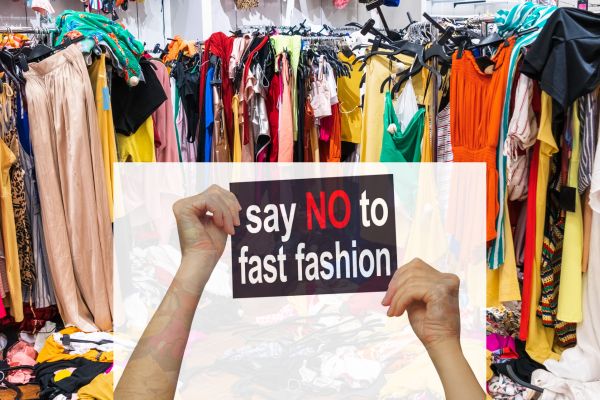Walking past the Forever 21 near my station, I noticed through those giant shiny glass panels that the entire collection changed since the last time I saw it, less than a week ago. This transition wasn’t unusual; popular fast-fashion chains like Forever 21, H&M, and Zara release new clothing lines every week. When I say clothing lines, I don’t mean a few new shirts, but entire collections, ranging from tank tops to formal suits. The designs often resemble those from runway shows, with just enough differences to avoid infringement. The materials are usually thin and shoddy, designed to be disposable. The styles and aesthetics change rapidly to keep up with the ever-shifting fashion craze, but all end up looking similarly soulless.
What’s under the racks of trendy clothes are some cruel statistics. Every year, billions of cubic meters of water go to the fashion industry – water that could have quenched the thirst of millions of people. As the second-largest industrial polluter, fast fashion is responsible for 10% of the global carbon dioxide emission. That’s more than the sum of flights and marine transportation. While some stores try to incorporate more sustainable materials into their products, the large number of consumers purchasing more clothes and wearing them for shorter periods outweighs the small progress companies are making. With all the advertisements and societal pressures pushing us towards overconsumption, it’s hard to resist the urge to shop on impulse. However, it’s also important to be aware of the harm we contribute to the environment with each seemingly harmless purchase, even something as small as a shirt.
If global warming doesn’t feel relevant enough, the impact of fast fashion is gradually seeping into our daily lives. Studies have found microplastics in the human body, attributable to the plastic bottles we toss away and the plastic-based materials like polyester and nylon commonly used in fast-fashion clothes. When produced and washed, the microplastics in these materials sneakily enter the waterways, harming marine life, entering our food chains, and eventually ending up in our brains, lungs, and kidneys. The “micro” part in the term may give the impression of innocuousness, but it could have “macro” impacts, such as DNA damage and increased cancer risk as it accumulates in our bodies.
But even before I delved into statistics of pollution and overconsumption, I was wondering: “How are these fast-fashion companies making profits if the price was so low?”
Sure, we have huge factories and advanced technologies, yet the cost of the materials, workers, utilities, and design just doesn’t seem to add up. What I found was eye-opening. According to the data from the Bureau of International Labor Affairs (ILAB), many manufactured goods, especially in the textile industry, are produced by forced laborers, including victims of human trafficking and minors. Often, these garment workers aren’t even treated with basic dignity: they work in dangerous, unventilated environments for more than 12 hours a day, with around 98% of them not earning a living wage. In Cambodia, one in three women garment workers has experienced sexual assault. There are nearly 160 million children aged 5 to 17 among these workers. The increasing demand for fast fashion has contributed significantly to the rise of labor exploitation, often referred to as “modern slavery.” All these cases are just the ones we know about; I wonder how many more dark secrets the industry keeps hidden.
Glancing at the Forever 21 dress I bought years ago, lying untouched in my closet, I imagine how it might have been sewn by calloused hands and destined to become part of the millions of tons of textile waste that’s poisoning our environment.
As clothes become more colorful, our world becomes grayer and lifeless. I ask all of us: Is the cost really worth it? Just because the industry takes advantage of the situation doesn’t mean we must play along. While everyone is the victim of fast fashion in different ways, we are the ones who can make conscious choices—unlike the children trapped in the factories. We have an opportunity to support local thrift stores and sustainable brands, a motivation to learn how to repair clothes, and a chance to build a more thoughtful wardrobe. Let’s all stand together and choose actions that are better for our environment, people, and future.
![]()
- United States
